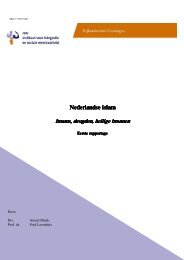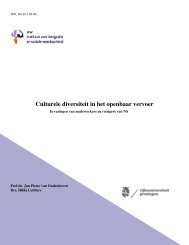Interventies voor een leefbare wijk: van theorie naar - Instituut ISW
Interventies voor een leefbare wijk: van theorie naar - Instituut ISW
Interventies voor een leefbare wijk: van theorie naar - Instituut ISW
You also want an ePaper? Increase the reach of your titles
YUMPU automatically turns print PDFs into web optimized ePapers that Google loves.
Hoofdstuk 4<br />
Arnhem, beleidsstuk. Het werkt in Het Arnhemse Broek. Actieplan Onze Buurt Het Broek (18<br />
juni 2007, 2 e versie).<br />
Arnhem, beleidsstuk. Gem<strong>een</strong>te Arnhem (september 2006), Voortgangsrapportage<br />
<strong>wijk</strong>werkplannen 2005.<br />
Arnhem, beleidsstuk. Integraal Veiligheidsprogramma 2008-2011 in de volle breedte, deel 2.<br />
Bennett, T. (1990). Evaluating Neighbourhood Watch. Gower Aldershot; Brookfield, USA.<br />
Crawford, A. (1998). Crime prevention and community safety: politics, policies and practices.<br />
Longman: Harlow.<br />
Innes, M. (2004). Signal crimes and signal disorders: notes on deviance as communicative<br />
action. The British journal of sociology, 55 (3), 335-355.<br />
Leeuw, F. (2008). Gedragsmechanismen achter overheidsinterventies en rechtsregels. Oratie,<br />
Universiteit Maastricht.<br />
Morenoff, J. D., Sampson, R. J. & Raudenbusch, S. W. (2001). Neighborhood inequality,<br />
collective efficacy, and the spatial dynamics of urban violence. Criminology, 39 (3),<br />
517-560.<br />
Nelen, H. (2008). Evidence maze: het doolhof <strong>van</strong> evaluatieonderzoek. Oratie, Universiteit<br />
Maastricht.<br />
Pawson, R. & Tilley, N. (1997). Realistic Evaluation. SAGE Publications: Londen.<br />
Sampson, R. J. & Raudenbusch, S. W. & Earls, F. (1997). Neighborhoods and violent crime: a<br />
multilevel study of collective efficacy. Science, 277, 918-924.<br />
Silver, E. & Miller, L. (2004). Sources of informal social control in Chicago neighborhoods.<br />
Criminology, 42 (3), 551-583.<br />
Hoofdstuk 5<br />
Akkerman, T., Hajer, M. & Grin, J. (2004). The interactive state: democratisation from above?<br />
In: Political Studies, 52, 82-95.<br />
Anastacio, J., Gidley, B., Hart, L., Keith, M., Mayo, M. & Kowarzik, U. (2000). Reflecting<br />
realities: Participants’ perspectives on integrated communities and sustainable<br />
development. Bristol: The Policy Press.<br />
Anderson, L. M., Evertson, C. M. & Emmer, E. T. (1980). Dimensions in classroom<br />
management derived from recent research. Journal of Curriculum Studies, 12(4), 343-356.<br />
Boer, N. G. J. de & Duyvendak, J.W. (2000). Buurten in de <strong>wijk</strong>, Verslag <strong>van</strong> <strong>een</strong> onderzoek.<br />
Den Haag: Van Deventer.<br />
Boekaerts, M. & Simons, P. R. J. (1995). Leren en Instructie. Psychologie <strong>van</strong> de leerling en het<br />
leerproces. Assen: Van Gorcum.<br />
Bourdieu, P. (1979/1984). Distinction: A social critique of the judgement of taste. Cambridge &<br />
Massachusetts: Harvard University Press.<br />
Bourdieu, P. (1987). The Forms of Capital. In: Richardson, J. G. (ed.). Handbook of Theory and<br />
Research for Sociology of Education. (241-258). New York: Gr<strong>een</strong>wood Press.<br />
Bourdieu, P. (1990). The Logic of Practice. Stanford: Stanford University Press.<br />
Burton, P., Croft, J., Hastings, A., Slater, T., Goodlad, R., Abbot, J. & Macdonald, G. (2004a).<br />
What works in community involvement in area-based initiatives? A systematic review of the<br />
120<br />
I n t e r v e n t i e s v o o r e e n l e e f b a r e w i j k






